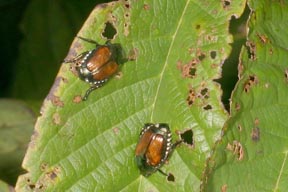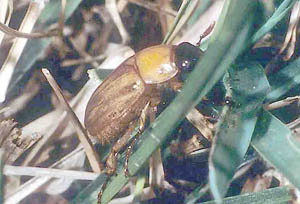White Grub Adult Scouting | |
|---|---|
| July 3, 2007 | |
|
Making estimations of the future impact of white grub damage to turf relies on more than rainfall patterns. The other factor involved is the number of adult white grubs present to cause damage. Scouting is necessary to determine the relative abundance of these beetles.  Japanese beetle adults on pawpaw. Japanese beetle adults are the easiest to scout because they seem to like the sunshine. Adult beetles are stout, oval insects 3/8 to 1/2 inch long, metallic green, with copper-colored wing covers. There is a row of white spots consisting of white hairs along the sides just below the wing covers, along with a pair of white spots on the posterior of the beetle. During the sunny portions of the day, these beetles can easily be seen feeding and mating on the upper leaf surfaces of smartweed, rose, grape, raspberry, blackberry, crabapple, serviceberry, birch, linden, and other trees and shrubs. When disturbed, they fly clumsily with a loud buzzing sound.  Masked chafter adult. Masked chafer adults are more difficult to scout. Illinois has both southern masked chafer and northern masked chafer throughout the state. The adults of these beetles are 1/2-inch-long, tan June bugs. They are stocky, roundish beetles that fly clumsily with a loud buzzing sound. These insects hide in the thatch during the day, coming out at night to mate and lay eggs. They do not feed as adults, so you do not see them do that on trees and shrubs. The two species emerge at slightly different times from dusk until after midnight; but from about 10:30 to 11:00 p.m., both species are active. Masked chafer adults can be seen flying back and forth just above the turf surface at that time of night. Shining a car’s headlights across the turf is an excellent method to see this activity. These beetles are also strongly attracted to lights at night, where their numbers can be easily observed. They are particularly attracted to illuminated white surfaces, so an outdoor light on a white building attracts more beetles than a pole light. They are more attracted to mercury vapor and regular incandescent lights than sodium or yellow light bulbs. Masked chafer adults can also be monitored somewhat by the frequency of the beetles’ hitting a lighted window or the number found swimming or drowned in pet water dishes, wading pools, horse troughs, birdbaths, and other bodies of water in the morning. Compare the number of beetles with previous years to determine the damage potential. This is where experience and memory become very helpful. Certainly, years when the number of beetles is smaller corresponds to less white grub damage to turf if moisture conditions are similar. |